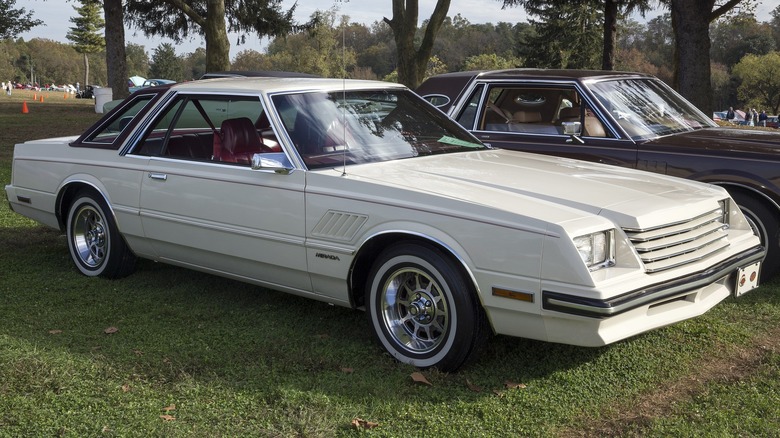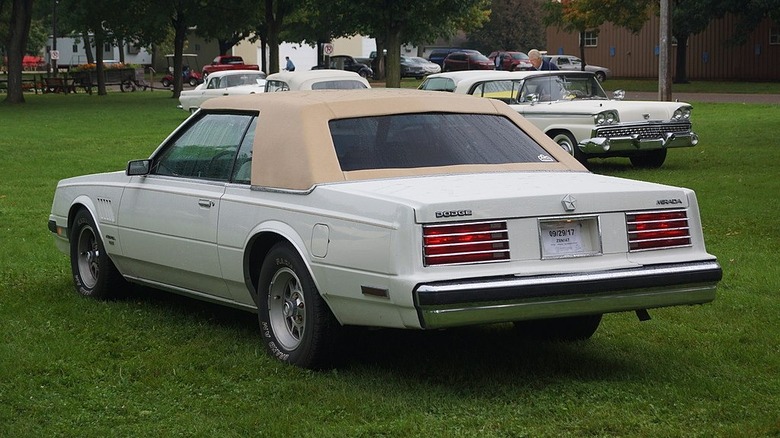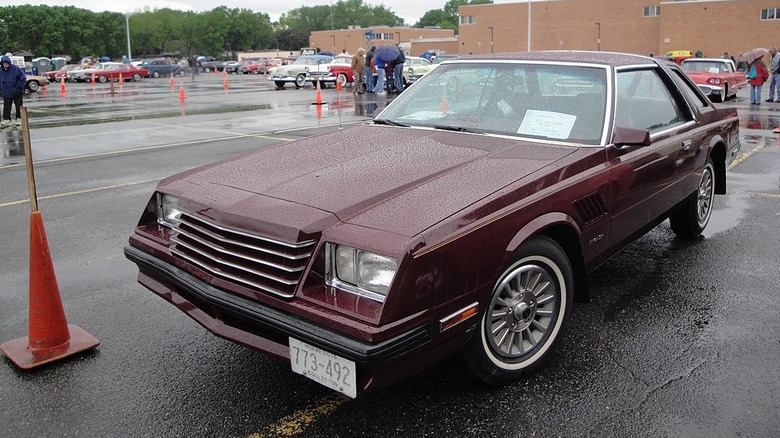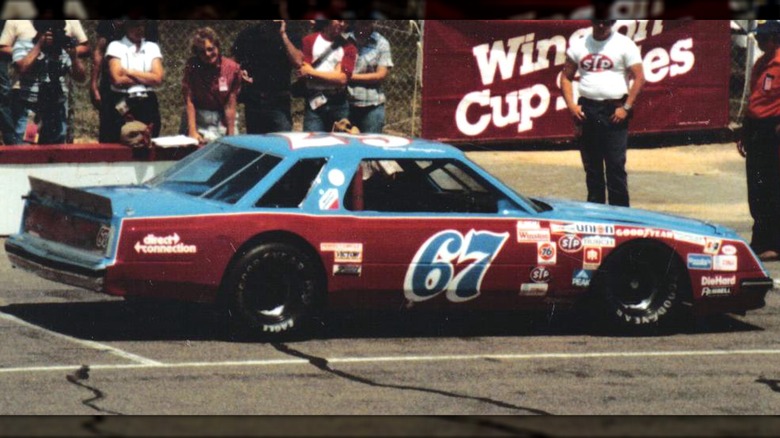Everything Mopar Fans Should Know About The Dodge Mirada
You're not alone if you've never heard of the Dodge Mirada. But you'll want to stick around because this long-forgotten land yacht from the 1980s is a rather peculiar oddity that's actually worth knowing about.
The Mirada lasted only three years (from 1980 to 1983) and was a short-lived piece of Dodge's high-end luxury. The world had just shut the door on the 1970s, a decade that saw everything from the Clean Air Act to never-ending lines at the gas pumps thanks to the onslaught of oil embargos by Arab producers. At the start of the 1980s, consumers were in the midst of the in-between, a period when big ole cars of the past were still part and parcel of the American landscape but, due to the events of the previous decade, were starting to be phased out. Yet, a vehicle's economic importance was still years away and insignificant next to the comfort it could provide.
For example, in 1979 alone, automakers sold over 1.5 million personal luxury coupes, including the Ford Thunderbird, Pontiac Grand Prix, Chevy Monte Carlo, Oldsmobile Cutlass Supreme, Buick Regal, and Mercury Cougar. In fact, Dodge specifically targeted these very cars in its ad for the Mirada in 1980. Interestingly, there was nothing really all that new about the Mirada (a Spanish word for "look" or "view"). It was fundamentally a Chrysler Cordoba (like the failed '70s Dodge Magnum) whittled down to fit on the smaller Dodge Aspen and Plymouth Volaré platform from 1976, making it 800 pounds lighter than the Mangum.
[Featured image by Mr.choppers via Wikimedia Commons | Cropped and scaled | CC BY-SA 3.0]
Imitation is the sincerest form of flattery
The Mirada cribbed the similar elongated front hood, short back deck, and linear features made famous by the 1975 Cadillac Seville. It did have a unique front end designed to give it a sportier look. However, even that was only partially original, as one reliable source claims it was inspired by the Cord 810 (one of the most beautiful pre-war cars ever built) and 812.
There was a choice of the 3.7-liter 225 cubic-inch Slant Six (kicking out only 90 horsepower and 160 pound-feet of torque). In 49 of the 50 United States, a 318 cubic-inch V8 strapped with a two-barrel carburetor produced 155 horsepower and 240 pound-feet of torque. Meanwhile, folks in California could grab a 318 V8 with a four-barrel carburetor packing 185 horsepower and 275 pound-feet of torque.
Lastly, a 360 CID V8 was available in the Mirada CMX (available everywhere but California), capable of making the same power numbers as the 318 V8 sold in California. However, this engine was discontinued after the inaugural 1980 model. A three-speed TorqueFlite automatic was the only transmission option, but the shifter could be mounted on the column or in a middle console.
Lee Iacocca, appointed president of Chrysler Corporation in 1978 and then chairman of the board in '79, loved vinyl landau roofs because they made a car look classy. Along with a half-top landau, there were options for a painted metal roof (with fixed opera windows), a Cabriolet roof, and, to further play up the "sporty" aspect, a power sunroof or glass T-top.
[Featured image by Greg Gjerdingen via Wikimedia Commons | Cropped and scaled | CC BY-SA 2.0]
Breaker, breaker, good buddy
In fact, Chrysler really went above and beyond when emphasizing the Mirada's sportiness (even though it wasn't) with the "Sport Handling Package." This option included a bevy of muscle car features like heavy-duty shocks, stiffer rear leaf springs, and thicker front and rear anti-roll bars. It used the buzzword "Firm-Feel" to describe the suspension and steering, while wide 10-spoke alloy wheels (slapped with 215/70R15 whitewall tires) rode the ground. A three or four-spoke steering wheel and a gaggle of gauges (speedometer, tachometer, temperature, fuel level, alternator, etc.) set amidst a brushed aluminum instrument panel rounded out the look.
Among the audio options was a premium speaker package powered by a 30-watt rear amplifier connected to either a state-of-the-art cassette or – believe it or not – an 8-track tape player. Keep in mind that in 1977 "Smokey and the Bandit" was released, making Pontiac's Trans-Am famous. It also turned CB radios into the must-have gadget, so buyers could get one installed ... in the dash.
The front seats were available in either a 60/40 front bench or bucket seat configuration. Buckets bought you a middle console-mounted shifter (and the brushed aluminum dash), while the bench came with the standard column shifter and a more refined simulated woodgrain dash. Material options included a cloth/vinyl combination and all vinyl or leather surfaces with vinyl trim.
[Featured image by Greg Gjerdingen via Wikimedia Commons | Cropped and scaled | CC BY-SA 2.0]
The NASCAR life
So, how can a (failed) mid-size personal-luxury coupe marketed with peculiar muscle car stylings end up on the NASCAR circuit? We're glad you asked.
Wanting nothing more than to succeed on the race track, Lee Iacocca went to great lengths to get none other than "The King" himself, Richard Petty, to use a Mirada in the NASCAR circuit. Petty and his team did, in fact, test one, but thanks to the front end ("inspired" by the Cords, if you remember), it had such poor aerodynamics that it made the car some 8 miles per hour slower than the Ford and GM offerings on the track.
Other teams also tested it, and all but one chose other manufacturer models. Arrington Racing, however, used it rather successfully (usually on the shorter tracks) from 1981 through 1984 and was able to achieve 15 top-ten finishes during that time. Both Dave Marcis and Dick May intermittently drove a Mirada during the '81 season, but more often than not, the car either broke down or, if they were lucky, finished several laps down.
The production Mirada was about as successful as the NASCAR version. Chrysler only sold 52,947 units during its short production run, with more than half (27,165) in its launch year of 1980 alone. Sales literally plummeted year over year until, in '83, it sold just 5,597 units, and Chrysler pulled the plug on the Mirada.
[Featured image by us44mt via Wikimedia Commons | Cropped and scaled | CC BY-SA 2.0]



